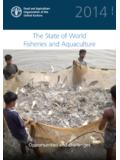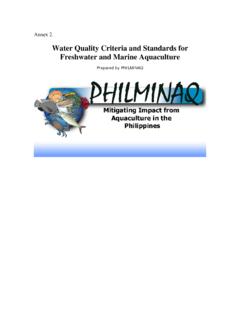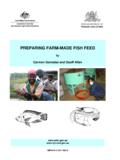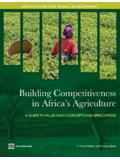Transcription of The State of World Fisheries and Aquaculture 2016
1 CONTRIBUTING TO FOOD SECURITY AND NUTRITION FOR ALLTHE State OF WORLDFISHERIES AND AQUACULTURE2016 HAI TIEN VILLAGE, VIET NAM. A beneficiary of an FAO TeleFood project that uses fish PHOTOGRAPH FAO/Pham CuRecommended citation:FAO. State of World Fisheries and Aquaculture 2016. Contributing to food security and nutrition for all. Rome. 200 designations employed and the presentation of material in this information product do not imply the expression of any opinion whatsoever on the part of the Food and Agriculture Organization of the United Nations (FAO) concerning the legal or development status of any country, territory, city or area or of its authorities, or concerning the delimitation of its frontiers or boundaries.
2 The mention of specific companies or products of manufacturers, whether or not these have been patented, does not imply that these have been endorsed or recommended by FAO in preference to others of a similar nature that are not 978-92-5-109185-2 FAO encourages the use, reproduction and dissemination of material in this information product. Except where otherwise indicated, material may be copied, downloaded and printed for private study, research and teaching purposes, or for use in non-commercial products or services, provided that appropriate acknowledgement of FAO as the source and copyright holder is given and that FAO s endorsement of users views, products or services is not implied in any requests for translation and adaptation rights, and for resale and other commercial use rights should be made via or addressed to information products are available on the FAO website ( )
3 And can be purchased through FAO 2016 Food and Agriculture Organization of the United NationsRome, 20162016 THE State OF WORLDFISHERIES AND AQUACULTURECONTRIBUTING TO FOOD SECURITY AND NUTRITION FOR ALLISSN 1020-5489 FOREWORDF isheries and Aquaculture remain important sources of food, nutrition, income and livelihoods for hundreds of millions of people around the World . World per capita fish supply reached a new record high of 20 kg in 2014, thanks to vigorous growth in Aquaculture , which now provides half of all fish for human consumption, and to a slight improvement in the State of certain fish stocks due to improved Fisheries management.
4 Moreover, fish continues to be one of the most-traded food commodities worldwide with more than half of fish exports by value originating in developing countries. Recent reports by high-level experts, international organizations, industry and civil society representatives all highlight the tremendous potential of the oceans and inland waters now, and even more so in the future, to contribute significantly to food security and adequate nutrition for a global population expected to reach billion by is in this context and with this high expectation that the 2016 edition of The State of World Fisheries and Aquaculture is being launched.
5 Several recent major international developments will further strengthen its key function as a provider of informed, balanced and comprehensive analysis of global Fisheries and Aquaculture data and related , the Second International Conference on Nutrition (ICN2), held in Rome in November 2014, adopted the Rome Declaration and the Framework for Action, whereby World leaders renewed their commitments to establish and implement policies aimed at eradicating malnutrition and transforming food systems to make nutritious diets available to all. The conference confirmed the importance of fish and seafood as a source of nutrition and health for many coastal communities that depend on their proteins and essential micronutrients, in particular for women of child-bearing age and young children.
6 It stressed the unique window of opportunity that Fisheries and Aquaculture can provide for ICN2 follow-up towards achieving healthy diets. With this greater awareness of the sector s important role in nutrition comes greater responsibility for how resources are managed in order to ensure nutritious and healthy diets for all the World s , on 25 September 2015, Member States of the United Nations adopted the 2030 Agenda for Sustainable Development and the Sustainable Development Goals (SDGs), a set of 17 aspirational objectives with 169 targets expected to guide actions of governments, international agencies, civil society and other institutions over the next 15 years (2016 2030).
7 The SDGs are the first global development push in history led by the Member States. They set out specific objectives for countries, developed and developing, to meet within a given time frame, with achievements monitored periodically to measure progress and ensure that no one is left behind. Several SDGs are directly relevant to Fisheries and Aquaculture and to the sustainable development of the sector, and one goal expressly focuses on the oceans (SDG 14 Conserve and sustainably use the oceans, seas and marine resources for sustainable development). To achieve the global transition to sustainable development, countries are now establishing an enabling environment of policies, institutions and governance grounded in a sound evidence-based approach that takes into account the three dimensions of sustainability (economic, social and environmental) with closely interwoven targets.
8 FAO and The State of World Fisheries and Aquaculture will play a frontline role in monitoring and reporting on specific targets relevant to FAO s mandate under SDGs 2 and , on 8 9 October 2015, 600 delegates representing 70 Members of FAO, the private sector, non-governmental organizations and civil society organizations met in Vigo, Spain, to celebrate the twentieth anniversary of the adoption of the Code of Conduct for Responsible Fisheries (the Code), and to take stock of its achievements and the obstacles encountered in its implementation. The meeting confirmed both the central role of the Code for the sustainable management of living aquatic resources, and the need to accelerate its implementation to meet the relevant SDG targets, in particular those of SDG 14.
9 The move from commitment to action to implement the Code entails an upscaled responsibility for analysis, monitoring and reporting for FAO and The State of World Fisheries and Aquaculture .| ii |Jos Graziano da Silva FAO Director-GeneralFourth, the twenty-first session of the Conference of the Parties (COP21) of the United Nations Framework Convention on Climate Change was held in Paris, France, in December 2015. It witnessed an unprecedented international agreement, the Paris Agreement. Its aim is to strengthen the global response to the threat of climate change, in the context of sustainable development and efforts to eradicate poverty, including by holding the increase in the global average temperature to well below 2 C above pre-industrial levels, increasing the ability to adapt to the adverse impacts of climate change, and fostering climate resilience in a manner that does not threaten food production.
10 COP21 prominently featured the role of oceans, inland waters and aquatic ecosystems for temperature regulation and carbon sequestration, and highlighted the urgency of reversing the current trend of overexploitation and pollution to restore aquatic ecosystem services and the productive capacity of the oceans. Current and future editions of The State of World Fisheries and Aquaculture will be a key source of information on progress in implementing the Paris Agreement and its pertinence to oceans and inland , FAO s efforts to address illegal, unregulated and unreported (IUU) fishing have yielded real results.















